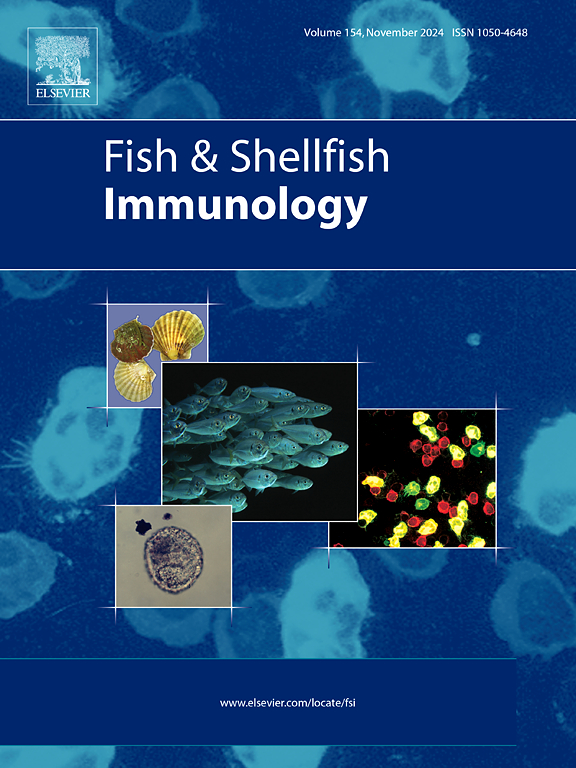对大鲵鳃和皮肤微生物群的分析揭示了与隐核虫耐药潜力相关的细菌。
IF 4.1
2区 农林科学
Q1 FISHERIES
引用次数: 0
摘要
隐核虫病是由刺虫引起的一种纤毛虫寄生虫,对海洋集约化养殖大黄鱼(Larimichthys crocea)造成严重威胁。本研究探讨了皮肤和鳃微生物群与C. irritans感染之间的相互作用,重点研究了共生微生物在抗病性中的作用。鱼被每克体重100个虫虫挑战,导致大量微生物生态失调,其特征是α多样性减少,共发生网络被破坏,特别是在皮肤上。感染后,鳃和皮肤的弧菌丰度显著增加,提示继发感染的可能性。相反,较低的弧菌水平与较高的类蛭弧菌(BALOs)种群相关,这可能在微生物平衡中发挥有益作用。鱼类表现出不同的易感性,轻度感染的个体表现出较少的组织病理学损伤和更强的免疫反应,这表明白细胞介素-1β (IL-1β)和白细胞介素-8 (IL-8)水平升高。相关分析显示,相对感染强度(RII)与微生物组成之间存在显著相关性,某些已知具有抗真核微生物特性的细菌与RII呈负相关。此外,氮代谢细菌的丰度也与RII呈负相关。功能预测表明,感染后与反硝化和维生素生物合成相关的细菌基因增加。值得注意的是,Candidatus Midichloria被认为是C. irritans感染的潜在生物标志物,并且被认为是C. irritans的内共生体,通过PCR分析证实了它的存在。这些发现阐明了C. irritans感染期间的微生物动力学,并提出了治疗隐核虫病的益生菌候选物。本文章由计算机程序翻译,如有差异,请以英文原文为准。
Analysis of gill and skin microbiota in Larimichthys crocea reveals bacteria associated with cryptocaryoniasis resistance potential
Cryptocaryoniasis, caused by the ciliate parasite Cryptocaryon irritans, poses a significant threat to the large yellow croaker (Larimichthys crocea) in intensive marine aquaculture. This study explores the interaction between skin and gill microbiota and C. irritans infection, focusing on the role of commensal microbes in disease resistance. Fish were challenged with 100 theronts per gram of body weight, leading to substantial microbial dysbiosis, characterized by decreased alpha diversity and disrupted co-occurrence networks, particularly on the skin. Post-infection, Vibrio abundance significantly increased in both gills and skin, suggesting potential for secondary infections. Conversely, lower Vibrio levels correlated with higher populations of Bdellovibrio-like organisms (BALOs), which may play a beneficial role in microbial balance. Fish showed varying susceptibility, with mildly infected individuals exhibiting less histopathological damage and a stronger immune response, indicated by elevated interleukin-1β (IL-1β) and interleukin-8 (IL-8) levels. Correlation analyses revealed significant relationships between relative infection intensity (RII) and microbial composition, with certain bacteria known for anti-eukaryotic microbial properties showing negative correlations with RII. Additionally, the abundance of nitrogen-metabolizing bacteria also correlated negatively with RII. Functional predictions indicated increased bacterial genes related to denitrification and vitamin biosynthesis post-infection. Notably, Candidatus Midichloria was identified as a potential biomarker for C. irritans infection and is thought to be an endosymbiont of C. irritans, with its presence validated through PCR analysis. These findings illuminate microbial dynamics during C. irritans infection and suggest probiotic candidates for managing cryptocaryoniasis.
求助全文
通过发布文献求助,成功后即可免费获取论文全文。
去求助
来源期刊

Fish & shellfish immunology
农林科学-海洋与淡水生物学
CiteScore
7.50
自引率
19.10%
发文量
750
审稿时长
68 days
期刊介绍:
Fish and Shellfish Immunology rapidly publishes high-quality, peer-refereed contributions in the expanding fields of fish and shellfish immunology. It presents studies on the basic mechanisms of both the specific and non-specific defense systems, the cells, tissues, and humoral factors involved, their dependence on environmental and intrinsic factors, response to pathogens, response to vaccination, and applied studies on the development of specific vaccines for use in the aquaculture industry.
 求助内容:
求助内容: 应助结果提醒方式:
应助结果提醒方式:


